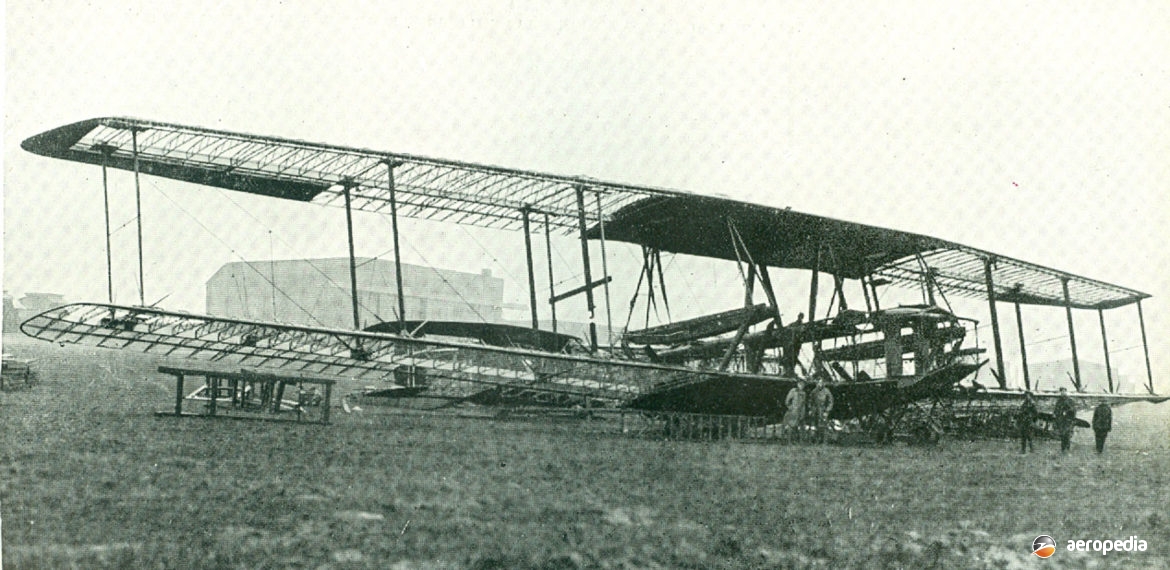Photograph:
The Zeppelin Staaken RX.IV captured by members of No 4 Squadron, Australian Flying Corps, at Bickendorf aerodrome near Cologne, Germany in December 1918 (AWM E4147)
Country of origin:
Germany
Description:
Long-range heavy bomber
Power Plant:
Four 183 kw (245 hp) Maybach Mb IVa six-cylinder in-line liquid-cooled engines
Specifications:
- Wingspan: 42.2 m (138 ft 5 in)
- Length: 22.1 m (72 ft 6 in)
- Height: 6.3 m (20 ft 8 in)
- Wing area: 332 m² (3,570 sq ft)
- Max speed: 135 km/h (84 mph)
- Rate of climb: 100 m/min (329 ft/min)
- Service ceiling: 4,320 m (14,173 ft)
- Time to 1,000 m (3,281 ft): 10 mins
- Time to 3,000 m (9,843 ft): 43 mins
- Time to 4,320 m (14,173 ft): 2 hrs 26 mins
- Range: 800 km (497 miles)
- Endurance: up to 10 hours
- Fuel capacity: 3,000 litres (660 Imp gals)
- Empty weight: 7,921 kg (17,463 lb)
- Payload weight: 3,400 kg (7,496 lb)
- Loaded weight: 11,848 kg (26,120 lb)
History:
Following the outbreak of World War I Graf Zeppelin and Robert Bosch, assisted by Gustav Klein, Helmut Hirth and Professor Baumann, commenced the construction of a series of large bomber aircraft, a facility for the construction of the aircraft being at Gothaero Waggonfabrik at the Gotha airfield being erected.
The Company built an aircraft designated VGO.1 which was powered by three 179 kw (240 hp) Maybach engines. It was flown for the first time on 11 April 1915. A second machine was the VGO.2, followed by the VGO.3, which became known as the R.III and had six 119 kw (160 hp) Mercedes engines.
In 1916 the Company moved to Staaken near Berlin and adopted the name Flugzeugwerft Staaken, later becoming known as Zeppelin-Werke Staaken.
Progression led to the R.IV, R.V and R.VI, the R.V having five 183 kw (245 hp) Maybach engines, one in the nose and the others paired in two nacelles driving tractor propellers. Principle production model was known as the Giant, being the R.VI, 18 being built at Staaken. Further examples were completed by Schutte-Lanz, Osdeutsche Albatros-Werke and Aviatik. This model had four Maybach engines which were mounted in two wing nacelles, two driving tractor propellers and two driving pusher propellers. The crew compartment was enclosed.
A few examples [eg R.30/16] carried a 90 kw (120 hp) Mercedes engine driving a compressor in the fuselage driving a Brown-Boveri four-stage supercharger. With this unit this aircraft attained an altitude of 6,000 m (19,685 ft) with a crew of nine and had a loaded weight of 11,600 kg (25,574 lb). One variant had twin floats and was operated on coastal patrol. During its production life the R.VI had the cabin extended forward to the extreme nose, the fuselage being raised above the lower wing by bracing struts.
Final production variants were the R.XIV, R.XV and R.XVI, the latter two being powered by five 183 kw (245 hp) Maybach engines. These models had a loaded weight of 14,502 kg (31,970 lb). The R.XVI was built under licence by Aviatik but only one example was completed, serial R.49/18 being fitted with two 373 kw (500 hp) Benz engines and two 179 kw (240 hp) engines in wing mounted nacelles, having a loaded weight of 14,651 kg (32,300 lb).
Further large bombers were on the drawing boards at the time of the Armistice and only one of these was completed after November 1918, this being the Rohrback-designed Staaken, which was of all-metal construction and had four engines mounted in a monoplane wing.
The R.VI series equipped two Luftstreitkrafte units, being Rfa 500 and Rfa 501, the first being delivered on 28 June 1917. These units first saw service on the Eastern Front based at Alt-Auz and Vilua in Kurland until August 1917 where nearly all missions were flown at night carrying 770 kg (1,698 lb) bomb loads and operating at between 2,000 and 2,400 m (6,500 to 7,800 ft). Later Rfa 501 was transferred to Ghent in Belgium for operations commencing in September 1917, later again moving to Scheldewindeke, while Rfa 500 was based at Castinne in France.
Rfa 501 made 11 raids on Great Britain between 28 September 1917 and 20 May 1918 delivering 27,190 kg (59,944 lb) of bombs in 30 sorties. The aircraft flew individually to targets on moonlit nights, using directional bearings by radio after take-off and using the Thames River as a navigational landmark. These missions lasted up to seven hours and none were lost in combat. However, four R.VIs were destroyed in combat, and six destroyed in crashes.
In the 1980s parts of R.VI serial R.34/16 were located at Poelkapelle, near Ypres, this aircraft having crashed on 21 April 1918 after a mission against a British airfield at Saint-Omer in France, being shot down by anti-aircraft fire.
Late in December 1918, when German aerodromes were captured by Allied forces and recovery of aircraft was taking place, No 4 Squadron, Australian Flying Corps, located and took possession of a grounded German bomber, thought at the time and recorded to be a Gotha G.V but which in fact was a Zeppelin Staaken R.XIV, this taking place at an airfield named Bickendorf near Cologne. This aircraft in photographs appears to be incomplete and it would seem it was either damaged, had not at that stage been completed, or was under repair. Certainly it was too large an aircraft to be taken as a War Prize and, as it was not airworthy, it is assumed in due course it was abandoned on the airfield and later broken up. Part of the terms of the Armistice was that all military aircraft be destroyed so no example of the type survives.

